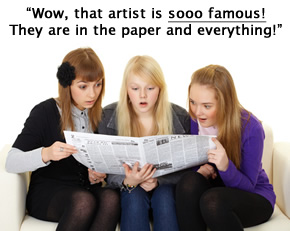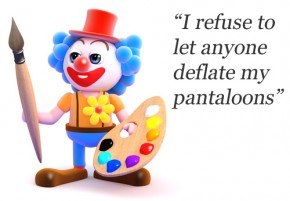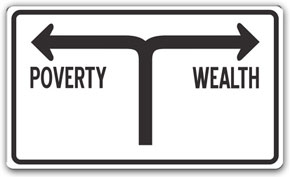Years ago when I first took the plunge into the professional art world I started out creating screen prints in runs of up to 100 at a time with home-made equipment in my Garage. I figured it would make sense to be able to distribute my wonderful works as widely as possible, and what better way than producing a ton of copies and then selling them to eager buyers.
At the time I was inspired by some local artists who seemed to have their work in every framing shop and exhibition that I saw around town. I figured that these guys were making it big, as their work seemed so popular.
They were themselves creating prints, both regular four colour process and handmade screen prints. Since the cost of a run of 1000 4 colour process (poster style) prints was many thousands of dollars and ‘Giclee’ colour inkjet printing was a mere twinkle in technology’s eye at the time, I opted for the home-brew screen printing approach.
Well, after a short while one of the local artists that I’d admired so much spotted my work in a shop and gave me a call. I was excited! He wanted to represent me himself and use his connections to get my prints into the outlets that he had access to. This made me even more excited.
He only wanted the very reasonable sum of 30% of the wholesale price as commission, and since my prints at that time retailed for the absolutely enormous sum of $100 each (Framing Shops like to make a 100% markup) that meant that I would receive the princely sum of $35 for each print, and therefore $3500 for a complete sell out of a print run. I was almost salivating at the thought. It actually seemed like a lot of money to me at the time.
I was feeling pretty cocky. After precisely 6 weeks in the business I had an art agent (of sorts) with connections. Gee, I thought. My art must be pretty good, obviously I’m a genius. With the benefit of hindsight I now realise that youth also comes parcelled with a delusional state of mind. I guess we’re designed that way by nature so that we strike out into the wilderness into adulthood without a thought as to the fact that we actually have the life experience related decision making capacity of a small rodent who has lived all his life running on a wheel in a hamster habitat. I digress.
Anyway, a week or so later I received another call. My new agent no longer want to be my agent, as his own agent now wanted to be my agent instead. Agents with agents? This could get confusing. It was revealed to me that my current opportunist artist agent in fact owed his own agent a big money type favour, and, in order to pay some of the debt I had been placed on the transfer list and been parcelled up as part of a deal.
I was even more excited. Now agents were trading me, and haggling to secure my services. In my mind I was a legend in my own lunchtime.
So, off I trundled to meet my new, and slightly bigger time agent, prints in hand and really without any clue whatsoever about how anything, including the art world, actually worked, or the reality that it entails.
The same deal was struck. 30% of the wholesale. I asked for some kind of contract agreement. Blank look. I asked again. You see I had read all about the art world in various ‘how things are officially done in the artworld books’ and knew this was the proper way to go about it. I expected to come away with a typed contract detailing who would do what and pay whom when. I actually left the agents abode with a note scribbled on a piece common-or-garden spiral bound jotting pad paper stating “I will take 30% commission and pay you within 30 days, signed, Ms Agent”. Fair enough.
Over the next few months I waited patiently for my agent to do her stuff, dreaming of the river of dollars potentially flowing my way. All that nasty selling stuff was being taken care of by ‘my agent’ (oh how I loved the ring of saying that phrase in idle party conversation, because everyone knows that if an artist has an agent then that artist ‘must be’ absolutely brilliant.)
Time came, time went. There were meetings, strategising and plans. I was going to be huge. The agent told me so. My work was going to sell like hot cakes. My Agent told me so. She actually sold precisely 5 prints. The agent reluctantly told me so, and then handed me a cheque and the remaining prints and wished me luck. I was relieved.
I was relieved because all of the time I was with the agent, the spoken agreement was that I would not try and sell prints myself, and by this time I was eager to actually get a return on my long sweaty hours spent in the garage. Undeterred I went out the next day and sold five prints directly to the local framing shops and small gallery’s. The shop owners gave me cheques directly in the hand. I liked that even better than the agent giving me a cheque. There was something very satisfying and direct about it. I made these things and people were willing to give me money right then and there. I still like that feeling today.
So, after all this, did I learn anything? Do I think art agents are good or evil for early career artists like myself as I once was?
My agent wasn’t evil. She had the best intentions. She just couldn’t sell my work to her clients. End of story. One of her other artists (the one who originally wanted to be my agent) was doing extraordinarily well with her, and making a handsome living out of it. My art just wasn’t right for her outlets.
If you can find yourself an agent who actually does have the skill and capacity to sell your stuff then this is good. It does have the advantage of allowing you more time to actually create your artwork, but, remember, your agent is going to have to sell a whole lot in order keep you in the manner to which you would like to become accustomed, and you can’t get go out there and sell your artwork directly by yourself when things get a bit slow, because that would be undermining what your agent is supposed to be doing for you.
If your agent is handling your original work as well as your prints, and representing you into proper art galleries, then remember, after gallery commission and agents commission, you might only be left with 35% of the retail value, so your art had better command a very respectable price, in order that you might make a decent profit.
I also learned that you can read all the ‘how things are done in the artworld properly’ books you like, but, at the end of the day if you can’t trust the person you are dealing with (ie they are evil) then a contract is not going to count for much anyway. Are you really going to sue a person if they don’t do what they said they would? Probably not, at least not early on in your career when the money is small. Life is too short. Move on.
Upon reflection I think I went with an art agent too early, before any kind of demand had been established for my work. If I’d done more direct selling for myself at the time I would have known fairly quickly whether there was enough interest to keep both myself and and agent well fed and watered. If the prints were actually flying out the door as fast as I could make them, and there was no time for me to process the sales then an agent would have been a wise move. As it was, my prints sold quietly and steadily over a number years as most print runs do (which was good).
So, if you are just starting out, maybe you should relax and be your own agent for a while. You’ll directly enjoy the thrill of people putting money in your hands for the things you make and you’ll experience the artworld first hand at the coal face. When you get so busy successfully selling your work that you don’t have enough time to make it, then, and only then it might be worth taking on an agent to do all that messy sales stuff for you.
Now you need to put down your brushes and read some stuff on how to close a sale. 😉












Great post, your story and experience is very inspiring! Hope you post more stories in the near future.
I Really loved this story. I think many of us getting ideal to have an agent
just like me because i use to work alone few years a goo with different big Circus and many Live event all over the world Different country’s But they didn’t give me what we they say to my contract now i De side to have agent so that i can still work nice get my salary and prosper my talent!
You are your best agent.
I loved this story. I think many of us get swept up in the whole ideal of having an agent and often the reality is very different from what we imagined. I too was snapped up by an art agent early on my art career and it was initially a very heady experience . However it very quickly becomes apparent that the agent and galleries often take the lions share of the profit and although I had orders pouring in for my work I became too involved in working to order and my inspiration soon dwindled. The exposure I received was brilliant but it came at a high price.
Im insireing to get an agent, who do you recommend ? I have 136 pieces compleate .
Thank you so much for this article — have been toying with the idea of getting an agent for a long time and I hear both good and bad things about it. Am forwarding this article to artist friends ^_^
It was a real good story and a real great help for a starter like myself. Thanks a tone.
The Concept of an Agent is much better than the practicality of it. In reality if an agent has too many clients then your artwork is competing amongst the other artists which can be good or bad depending upon public demand by contrast. If the agent has multiple clients they care not weather your work sells over another artists, that said, agents with multiple contacts may command a smaller premium. If an agent has too few clients aside from them being inexperienced they will require a higher margin to sustain themselves, which mean you get less for your hard work. Factor in income taxes if your using commercial money instead of Gold and Silver and you’ll be lucky to make out with enough cash to buy bread after paying the rent.
What i suggest is you find an out of work relative who wouldn’t mind living with you, who is well connected and cleans up nice and is presentable who can show your work “samples, prints, and originals” to prospective buyers, bring your works to parties and invite people to speculate about the artists meaning behind this or that while enjoying a complementary glass of wine. * buy bulk to save money.
make sure to have a guest list at each party where people can sign up to receive email or written notification of another “social” where more of your art will be on show.
Great post here! Thanks for halting me in my tracks a bit!
this was a good article to give something to think about my husband is a great artist we have been dealing with out any agent for our 12 years but need to go to the next level so this is really food for thought thanks Betsy
I found this article because, as a semi-connected, driven but not-as-talented-as-my-artist-friends kind of guy I want to BE an agent. Not for “regular” artists that are capable of doing it themselves but for the socially awkward/inept artist who would rather keep their works at home until they are sold or at least about to be sold.
My theory wasn’t to take any certain percentage that would come out of the artists’ pockets but instead ask them “how much do you want me to get you for this?” then adjust the selling price as to what I think the buyer would pay. That way the buyer pays me & the artist gets 100% of their asking price.
Why more people don’t do it that way I don’t know.
Thats a very nice idea. There are a lot of artists that are terrible sales people and most artist have full time day jobs. It is so hard to find time to make art and then go out and sell it. I would love to cut out the selling part. but alas, its part of the job.
I really understand what you are saying Kelly,
I have been producing art for years and I write also… put many poems in my paintings. Thought if I got my website put up with quite a bit of my work I would be set… I know my work is good but something happened to getting into the site and now I cannot manage it! … I work full time as a realtor in the Vegas Valley and it’s tough. I do not know where to turn. I think your way is good… some of us have no idea how to market ourselves! My website is BonnieMarie.org and I need help with who to go to!
Kelly, will you be my agent?
what area are you in? I’m looking for an agent.
dear Kelly I am a artist looking for help I am an intervert and want to be a recloose artist and do not relish the thought of going to art shows and such. I have had many many people tell me that I should be ritch but do not know how to go about it.I am very poor at this time and I am about to loose my home. Please help me
all good thoughts and useful info. the idea of getting an agent had crossed my mind, as I just completed an art painting I was commissioned to do by a client in my town. the project was successful and now I’m considering doing more artwork on my own, but exploring ways I could best market the product.
My art is unique in my stile and content. I could arrange to send you memory from my camera. 818 207 5105 not good with my wifes computer could you call me please!
hello my name is sergiu . I am artist ……… is possible a collaboration?
I want to sell something of my painting…
Here you can see some pictures….
http://www.flickr.com/photos/40950494@N08/
I am (desperately) trying to locate an agent named Milton Avery. (This is NOT the same person as the artist that died in 1965.)Eliyahu_AncientMusic@yahoo.com
Great post this starts my path about agents
Looking for an agent, I can’t sell worth anything
i read with interest the article about the pros and cons of having an agent, I’m looking to sell my watercolours, they are depictions of Elves, Fairies and Pixies, the colours are stupendous! as is the subject matter and the execution of the subject matter, If anybody out there has any ideas as to how to promote my paintings (and every one is a one off!) please let me know by e-mail, Thanks, Kind Regards< Rayy Webb.
Are you still interested in representing painters? check out “Recent Work” on my website and see if you’d be interested in representing me.
Very informative and insightful. Nobody has the passion and knows the product better than the artist him/herself. The problem lies when the artist doesn’t know the true value of his own work. I tend to underprice my work because I love to create so much, and I really like my clients and don’t have the guts to ask the kinds of prices they bring at auction. This is where an agent can work, but only if they produce. I already have made a name and demand for my work in a very specialized collectibles field, and now want to branch out to do special seminars, etc. so it would require an agent with a specialized set of networking tools. My “problem” if you can call it that is I never have any product to sell. Everything is usually gone within 24 hours of completion.
good for you. 🙂 Im sure most artists would love to sell everything they make in 24 hours!
i would love to have my agent one day to sell my work,and get my clients demand of my work and hopefully get myself a styl findout my identity.
wow! this was absolutely what I needed I’m in a tailspin and a lot of confusion on what to do at this point in my second career. Thanks to this article it made me laugh and think and most of all realize the most important thing for me is to not be so hasty on decisions because my biggest problem could be my straight downfall which is the “I want it now!” flaw of mine. Thank you again
Hello,
I’m looking for an agent or gallery that will promote and sell my work.Also searching for investor,online and real world shops for selling my pieces.I am interested in selling my artwork to individuals and galleries over internet. I am also interested to work on commision, or for projects. For further information please contact me via e-mail : klatuu.ruda@gmail.com
I am an Artist that create’s every day. Truely gifted in all mediums. Every thing i have ever done is an original idea, spawn in my head along with endless ideas. Every Piece, be it sculpturing, painting, tattooing, body art, clothing designs, Metal art, woodworking, air brushing, singing, music, hair, and absolute freehand work. Im not bragging just looking for advice, and someone who can keep up and sell me. do not take my word for it. please come check me out. I am a master artist and i’ve never been trained. i do not know where it comes from, but it is real. Please? anybody out there that might know what I should do, Respond. mccarthyderek4@gmail.com
I’d suggest taking some of that creativity and applying it to selling the work for yourself at first. Figure out if there is a market for what you do. If there is, and it sells in quantity and you can prove that to a serious gallery or agent then maybe you’ll have a chance with them.
Dear Stuart, I graduated with an MFA in drawing and painting in 1986. There were no DIY computer generated images then. I worked various jobs until two years ago, now at 61 years of age, I can get on with my career. I make surrealistic images of everyday working people in Photoshop. I’m making 1,000 images a month, and have about 6,000 on hand today. I expect to have 10,000 by spring. If I don’t need an agent at this point, what then, do I need? A management brokerage? Help? Any suggestion will be cherished. Thanks. Richard
Maybe a good place to start would be to figure out for yourself if there is a market for what you create. Who is going to buy these images and why?
30%?!? A good and honest agent (especially a starting agent) would most likely only request 10-20% commission and would never work exclusive. A good agent can become an artist’s best friend, but always be leery of agents that request exclusive rights. An agent that believes in your work enough to ask only 10% commission is worth considering for a future raise to 30%. A good agent is someone who believes in your work and is realistic about your market and your potential, and is willing to take those risks.
Great post! Thanks for sharing!
R
An agent on less than 30% will probably go out of business real quick. I would say be wary of someone who chooses to take a small commission. A good agent who does the business is worth paying. It pays to hire the best. The best dont work for 10% unless the deal is worth tens thousands of $$$ per piece.
art representatives are absolute ***. My mom has one, she used to be our main source of income but she hasn’t made anything this year. They have literally ruined our family’s lives.
Sorry to hear you havent had a good agent experience, but thats a bit of a generalisation – an agent that has the connections and is able to sell in volume is absolute gold – but of course if they dont sell and the artist is contracted to them then it can be a disaster. Maybe your mom should get a new agent or do the selling herself.
These articles have all been a great help. Its interesting reading thw different experiences. I was thinking about getting an art agent, but now im going to try snd market my eork myself for a while.
i have a girlfriend who is an artist and who does free lance work for book publishers and advertising agencies; I am from the tech world where the standard fee is 15 percent and I was shocked to learn that she payed 30 percent. You guys are getting ripped off.
So, my art representative recently cut me off but said she wanted to find commissions for me. I am worried the only reason she says this is because my friend came up to me and offered me a commission first. My gal is expecting a cut but she is not my agent anymore. There were no contracts. The commission is not finalized year and has been on hold for a few months. I don’t feel comfortable giving her part of my commission now that she does not represent me. Help!!
With these kinds of things often its just a case of ‘your word is your bond’. If you have an agreement for commissions with your ex agent then I’d say its up to you and your conscience to follow through on that. If there is no agreement in place and your agent did nothing to help you gain the commission then surely the agent would have no right to a commission payment. Sometimes though there is more to it than that. If you think your ex agent will help you to find future commissions and you expect to be still working with this person sometimes its a case of paying a commission just to keep things sweet and save any disagreement.. because that shows you are true to your word and encourages an agent to do more for you. But if you ‘been cut off’, the relationship is basically over and you have no legal agreements then I’d say move on, keep all the cash 🙂
I have had an agent for 3 years and made 160 bucks. My work is available all over the internet now in many top online stores. My last 1/4 I made 20 bucks. I find this hard to believe when I see comparable art. It may be I am not selling. It’s a difficult thing to know because my agent is in another country. So heartbreaking as an artist.